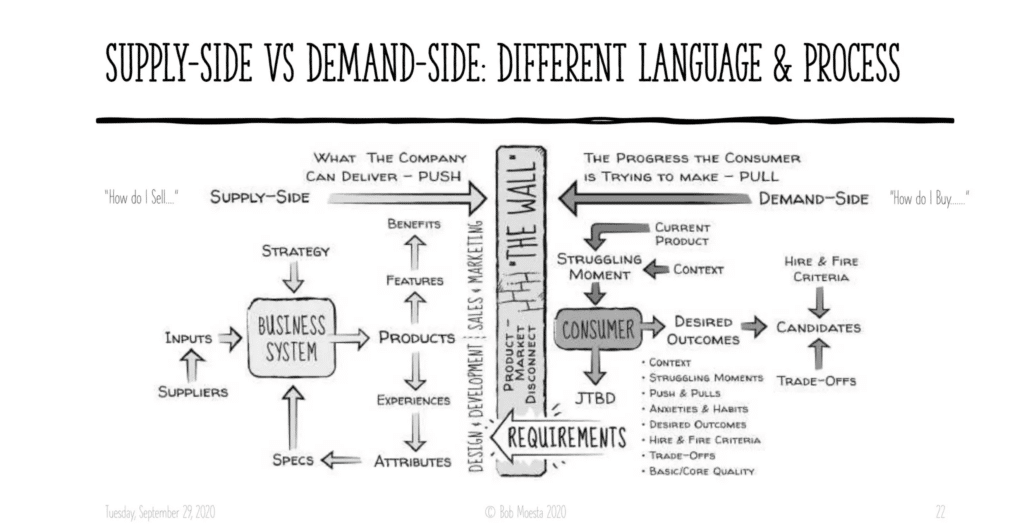Traditional sales are not in sync with the way people buy. They say up to 60% of b2b purchase processes end in no decision. That’s because we overwhelm our buyers.
We just throw features at them.
We expect them to make sense of our offering.
We put them in our sales pipelines, and expect them to act and consume in the same way.
Think about that last meeting you had with the team to discuss why you missed this quarter’s numbers. Chances are, a lot of what you discussed was based on what-ifs, hunches, and guesses – rather than actual qualitative data.
I bet the customer didn’t get a say in that meeting.
So, can you overcome indecision? We’d suggest you can, but it’s not to do with persuasion.
Instead, it’s about letting go of these assumptions we get told in “sales training 101”.
Assumptions we’re making that impact the sales process
You think that sales is about convincing people, and you can convince anyone to do anything.
People buy for their own reasons. The customer defines the value. The key to unlocking it all is understanding the customer, and then your product… and how it fits into their lives.
People buy things randomly.
Are you guilty of saying “If I get my product in front of enough people, eventually it’ll sell. It’s a numbers game”. Sales isn’t about finding people, it’s about creating demand for your product.
Sales are caused, and you must build a system.
Build it and they will come. Product does not create demand.
The way you create sales is by fitting your product into customers’ life by understanding the progress they are trying to make. We say that your product isn’t the burger, it’s the mustard. Your product plays one tiny part in a customer’s workflow and the job they need to get done.
Recognise this and the sales process will start to become enjoyable, predictable and repeatable.
How do you synch your sales process to the way people buy?
Buying is very different from selling. The best sales process mimics the progress that people are trying to make in their lives. Selling is clearly a supply side perspective, while buying sits on the demand-side.
I’ll say it again: traditional sales are not in sync with the way people buy.
To get the traditional sales process in sync, then, we need to flip the focus of sales from supply-side selling to demand-side selling. Spoiler alert; once you see it you can’t un-see it. Learn more about demand-side sales.

Let’s contrast the two.
Supply-side:
The focus is on the product or service and its features and benefits. How will I sell it? Who needs my product? You define demand through the product. In this scenario, the consumer is usually nebulous. They’re an aggregated set of demographic and psychographic information.
With supply-side thinking the focus is on the profit—the product must make money inside a specific cost structure. Everything you talk about goes through the lens of the product or service. You push your product. The supply-side does not see how the product fits into people’s lives. It’s the fishbowl analogy: You cannot see the whole picture swimming on the inside, only what surrounds you.
Demand-side:
The focus is on understanding the buyer and the user. How do people buy and how do they make progress? What’s causing them to make a purchase? You design your go to market strategy around the buyer’s worldview, not the product. You are looking at the world through a real buyer’s eyes. It’s understanding value from the customer-side of the world, as opposed to the product-side of the world.
Demand-side selling is understanding what progress people want to make, and what they are willing to pay to make that progress. Our product or services are merely part of their solution. You create pull for your product, because you are focused on helping the customer. Demand-side selling starts with the struggling moment. It’s the theory that people buy when they have a struggling moment and think, “Maybe, I can do better.”
Traditional economics thinks supply and demand are connected. But we would say that demand is independent of supply. Demand is about a fundamental struggle.
Supply and demand are two completely different perspectives in sales. You can read more about the differences between demand-side and supply-side.
Or, if you’d like to learn how to apply these principles of synching selling to the way people buy, why not check out Flip the Lens, our JTBD coaching. We’re accepting applications.